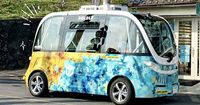A revolution in transportation is underway in Japan, as autonomous driving technology continues to evolve and gain traction across various domains. From public buses to ride-sharing services, the movement toward fully autonomous vehicles is on the rise, aiming to enhance safety, reduce operational costs, and address the growing driver shortage.
In a pioneering step, Toyonaka City, in collaboration with Kansai Electric Power Co., Ltd., Tokio Marine & Nichido Fire Insurance Co., Ltd., and Hankyu Corporation, is set to conduct its first Level 2 autonomous driving verification trial using an electric vehicle (EV) bus from March 26 to March 28, 2025. This initiative will navigate the streets of Shin-Senri Higashimachi while simultaneously exploring the social implementation of wireless EV charging.
This project aligns with ongoing endeavors to enhance urban mobility through green, low-speed electric means. “The trial will not only verify the bus’s capabilities but also serve as a platform for future developments in fully autonomous services,” said Toyonaka's mayor, Shigeki Nagauchi.
Meanwhile, the advancements don’t stop there. On March 17, 2025, Japan Airlines (JAL) in partnership with NEC Corporation will launch a demonstration experiment for an autonomous bus at the Haneda Airport maintenance area. The focus here is to automate driver-related tasks and test a facial recognition boarding system for JAL employees using NEC's technology, enhancing both safety and convenience.
During the experiment period running until March 24, the JAL staff will experience autonomous transport between facilities, facilitated by an autonomous driving system featuring real-time remote monitoring and safety checks. “Our objective is to integrate advanced automation into airport processes,” stated a JAL spokesperson.
The journey toward fully autonomous public transport gained momentum in November 2019 when a Level 4 autonomous driving service trial took place at the roadside station “Kamikoani” in Kitaakita City, Akita Prefecture. This service operated on dedicated lanes and marked a significant milestone for autonomous systems on public roads, despite critiques regarding the limited scope of its operations.
The Japanese government is keen on expanding this initiative. New legislation passed in 2021 established the groundwork for the regulation of autonomous driving systems, with services classified into specifications such as “specified autonomous driving” set for full implementation by 2023. As a result, the level of autonomy in services like the “ZEN drive Pilot” has progressed—this bus system received Level 4 approval in March 2023 for its route in Eiheiji Town.
In October 2023, two significant entities received Level 4 approval: TIER IV's “AI Pilot” at GLP ALFALINK in Sagamihara and BOLDLY's autonomous bus “ARMA” at Haneda Innovation City, showcasing the rapid advancements being made.
Continued innovations have been seen across different localities, with the introduction of autonomous buses in Ibaraki Prefecture by Sakai City in November 2020, marking a landmark as the first local government to regularly operate autonomous buses on public roads.
The costs associated with these advances are significant. Reports from the Mobility Working Group indicate that vehicles used for these services can range from 55 million to 80 million yen each. Initial setup costs also add an additional range of 10 million to 20 million yen, bringing the total investment to potentially astronomical figures.
Yet, advocates argue that the long-term benefits, including safety improvements, operational cost reductions, and alleviation of the driver shortage, will outweigh these upfront costs. The Japan Bus Association noted that personnel costs make up over 50% of operational expenses, which can drastically reduce with automation. In fiscal year 2021, only 19 out of 228 bus companies were profitable, emphasizing the urgency for cost-effective solutions.
“The introduction of autonomous driving technology can significantly enhance transport safety,” remarked an analyst from the ASV Promotion Examination Committee. Statistics reveal that 90% of traffic accidents are caused by human error, and implementing autonomous systems could drastically reduce the number of accidents.
As all these developments unfold, public and private entities are working keenly to establish a sustainable model for the future of transport. Plans aim for year-round operation of autonomous services in 50 locations by 2025 and an ambitious target of more than 100 by 2027, as more areas are showing interest in adopting this technology.
Japan's path toward autonomous driving is paved with trials, potential, and challenges, but the momentum is undeniable. Not only does it promise an evolution in transport but also aims to reshape societal mobility and environmental impact, steering the country into a new era of intelligent transport.







